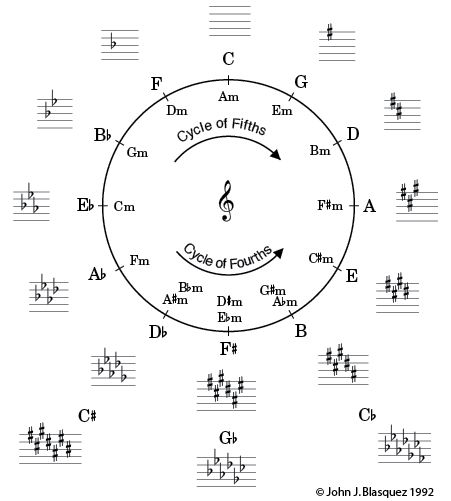Here are some things you will need to know for the final exam.
- List of sharps: F, C, G, D, A, E, B (remember the cat)
- List of flats: B, E, A, D, G, C, F (opposite of sharps)
- Circle of Fifths
- There are 15 MAJOR key signatures because of ENHARMONICS (an enharmonic is a note which is the equivalent of some other note, but spelled differently). See C# & Db, F# & Gb, B & Cb above. (Ignore the key signatures written in the center of the circle)
- If you learn the Circle of Fifths and the sharp key signatures, you should be able to do quite a few questions on the exam.
- Remember that TRIADS are the first, third and fifth notes piled on top of one another to make a CHORD. Major triads use the sharps and flats found in the key signature.
- Here are some terms you should know: a tempo, cantabile, fermata, legato, marcato, pentatonic, ritardando, simile, tenuto
- Remember that when you count 8th notes, it's 1 and 2 and 3 and 4 (or 1 + 2+ 3 + 4 +)

- When you count 16th notes, it's 1 e + a, 2 e + a...

- When you have a PICK-UP note, you subtract the same note value from the end of the piece.
- The Barcarolle was written by Jacques Offenbach for the opera "Tales of Hoffman." It is supposed to sound like you are floating in a small boat down the canals of Venice (a barca is a boat).
- St. Paul's Suite was written by Gustav Holst
- The theme for the Fantasia on a Theme from Thailand is the Pong Lang Dance. It is based on a pentatonic scale, as is much Asian music. The Pong Lang is a wooden xylophone with 12 wooden bars that, with a strong rope, are tied together in a row at each end. The lower pitch end is attached to a post or part of a tree and other is hooked to the player's toe or another material. The two performers sit on either side, one playing the melody, the other playing drone accompaniment.

- Be ready to compose a piece using triads.
- There will be a bonus musical joke. I will give you a hint during the exam.

REMEMBER: Follow directions. The most points lost are usually due to students NOT reading the directions thoroughly.
No comments:
Post a Comment